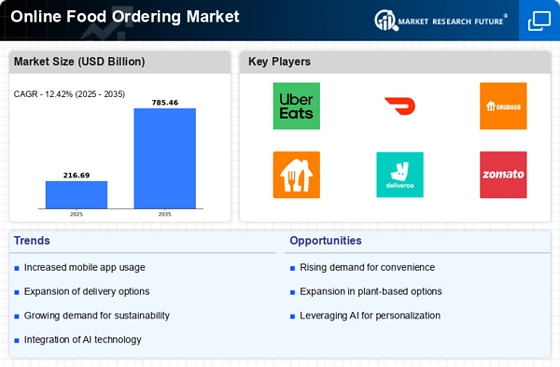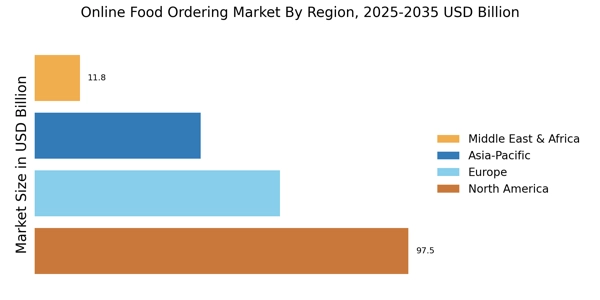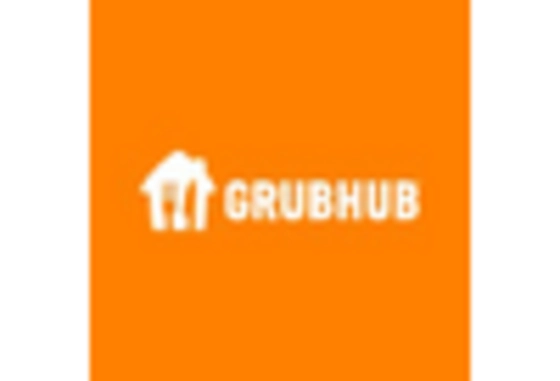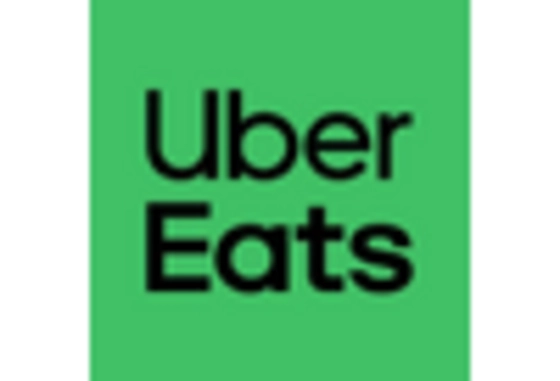Diverse Culinary Options
The Online Food Ordering Market is significantly influenced by the increasing availability of diverse culinary options. As consumers become more adventurous in their food choices, the demand for various cuisines has surged. This trend is reflected in the rise of food delivery platforms that offer a wide range of international and local dishes. Data indicates that nearly 70% of consumers are willing to try new cuisines when ordering online, which suggests a shift in dining habits. Consequently, restaurants and food providers are expanding their menus to cater to this evolving consumer preference. The Online Food Ordering Market is thus likely to see continued growth as it adapts to the diverse tastes of its clientele.
Technological Advancements
Technological advancements play a pivotal role in shaping the Online Food Ordering Market. The integration of mobile applications, artificial intelligence, and data analytics has transformed how consumers interact with food delivery services. For instance, the use of AI-driven algorithms allows platforms to offer personalized recommendations, enhancing the user experience. Furthermore, mobile app usage for food ordering has increased, with reports indicating that over 50% of online food orders are placed via mobile devices. This trend underscores the importance of technology in driving consumer engagement and satisfaction. As these technological innovations continue to evolve, the Online Food Ordering Market is expected to expand, attracting more users and increasing overall market share.
Convenience and Time-Saving
The Online Food Ordering Market thrives on the increasing demand for convenience and time-saving solutions. Consumers today lead busy lives, often juggling work, family, and social commitments. As a result, the ability to order food online with just a few clicks has become a preferred choice for many. According to recent data, approximately 60% of consumers express a preference for online food ordering over traditional dining options due to the ease it provides. This trend is likely to continue as technology advances, making the ordering process even more seamless. The Online Food Ordering Market is thus positioned to benefit from this growing consumer preference, as more individuals seek efficient ways to satisfy their dining needs.
Changing Consumer Preferences
The Online Food Ordering Market is experiencing a shift in consumer preferences, particularly among younger demographics. Millennials and Generation Z are increasingly favoring online food ordering as a primary means of dining. This demographic is characterized by a strong inclination towards convenience, variety, and the ability to customize orders. Recent surveys indicate that over 65% of younger consumers prefer ordering food online rather than dining out. This shift is prompting restaurants to adapt their business models to cater to this tech-savvy audience. As consumer preferences continue to evolve, the Online Food Ordering Market is likely to see sustained growth, driven by the demands of these influential consumer segments.
Increased Focus on Delivery Services
The Online Food Ordering Market is witnessing an increased focus on delivery services, which has become a critical component of the food service sector. As more consumers opt for home delivery, restaurants are investing in their delivery capabilities to meet this demand. Data shows that the delivery segment of the food service industry has grown by approximately 20% in recent years, indicating a robust trend towards home dining experiences. This shift is not only beneficial for consumers seeking convenience but also for restaurants looking to expand their customer base. The Online Food Ordering Market is thus likely to continue evolving, with delivery services playing a central role in its growth strategy.


















Leave a Comment